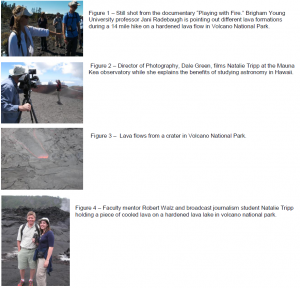Natalie Tripp and Professor Robert Walz, Communications
Playing with Fire is a documentary I started working on in the spring of 2010 after meeting Brigham Young University faculty member Dr. Jani Radebaugh. Dr. Radebaugh is a phenomenal geologist and is known around the world for her work in planetary geology, particularly for her studies of volcanic activity in our solar system. Lately, Radebaugh has focused her research on the volcanoes of Io, a moon of Jupiter and the most volcanically active body in our solar system. As Radebaugh watches the volcanic activity on Io, she believes she is more capable of understanding what early Earth looked like and even how our home planet might have been created.
The following summer my documentary team, comprised of myself, my faculty mentor Robert Walz, and my director of photography Dale Green, followed Radebaugh around the Hawaiian Islands as she studied the different terrains and lava flows from different eruptions. Our 10 day trip started on the island of Oahu where we spent a lot of time under the waves. The island of Oahu was created by a series of volcanic eruptions more than five million years ago that lasted for several hundred thousand years, but in order to really study those eruptions you have to reach the newest layer which has been preserved in the warm pacific waters. My team followed Radebaugh with our underwater camera on a couple of diving excursions through lava tubes, which are formed when lava rushes out of a volcanic crater like a river and the outside layers harden leaving a hollow shell behind.
The majority of our trip was spent exploring the Big Island of Hawaii, which is the most volcanically active island in the Hawaiian Island chain. In Volcano National Park our group explored lava tubes that were above the water and much younger than the formations on Oahu. One of the many highlights on this trip included acquiring special permits to journey off the beaten path in Volcano National Park and hike across a field of hardened lava from an eruption in 1976 that wiped out a number of homes and destroyed part of the highway that circles around the island. Our morning hike turned into an all-day trek covering a little more than 14 miles, but we were finally able to get up close and personal with some real flowing lava.
The other advantage Hawaii has to offer a planetary geologist like Dr. Radebaugh is the Mauna Kea Observatory. Sitting at the highest elevation in the state of Hawaii, and on top of a dormant volcano, the Mauna Kea Observatory plays host to a variety of large telescopes owned by countries from all over the world. Hawaii is one of the best places on the planet to study astronomy because there is very little light pollution when you’re away from the big cities and in the middle of the ocean, and the observatory sits far above the clouds at 14,000 feet above sea level where the air is thin and clear. A lot of the information Radebaugh uses for her studies comes from the telescopes at Mauna Kea and is transmitted via the internet to the Eyring Science Center at BYU.
There is an old Hawaiian legend about the volcano goddess named Pele and a native woman who defied the priests of Pele and brought Christianity to the islands. One of the underlying themes of my documentary focuses on the scientific advances brought about by women i.e. Marie Curie, Jane Goodall, and now, Jani Radebaugh.
When I returned to school for the 2010 Fall semester, I began writing a script for my documentary and logging the more than 50 hours of footage we had filmed. I am currently in the process of editing all of the video together and the final documentary should be completed in February of 2011.
Documenting Dr. Radebaugh’s work has been very eye-opening and inspiring to me, not only as a student who’s eager to learn, but also as a young woman who’s looking to blaze her own trail in this world.

